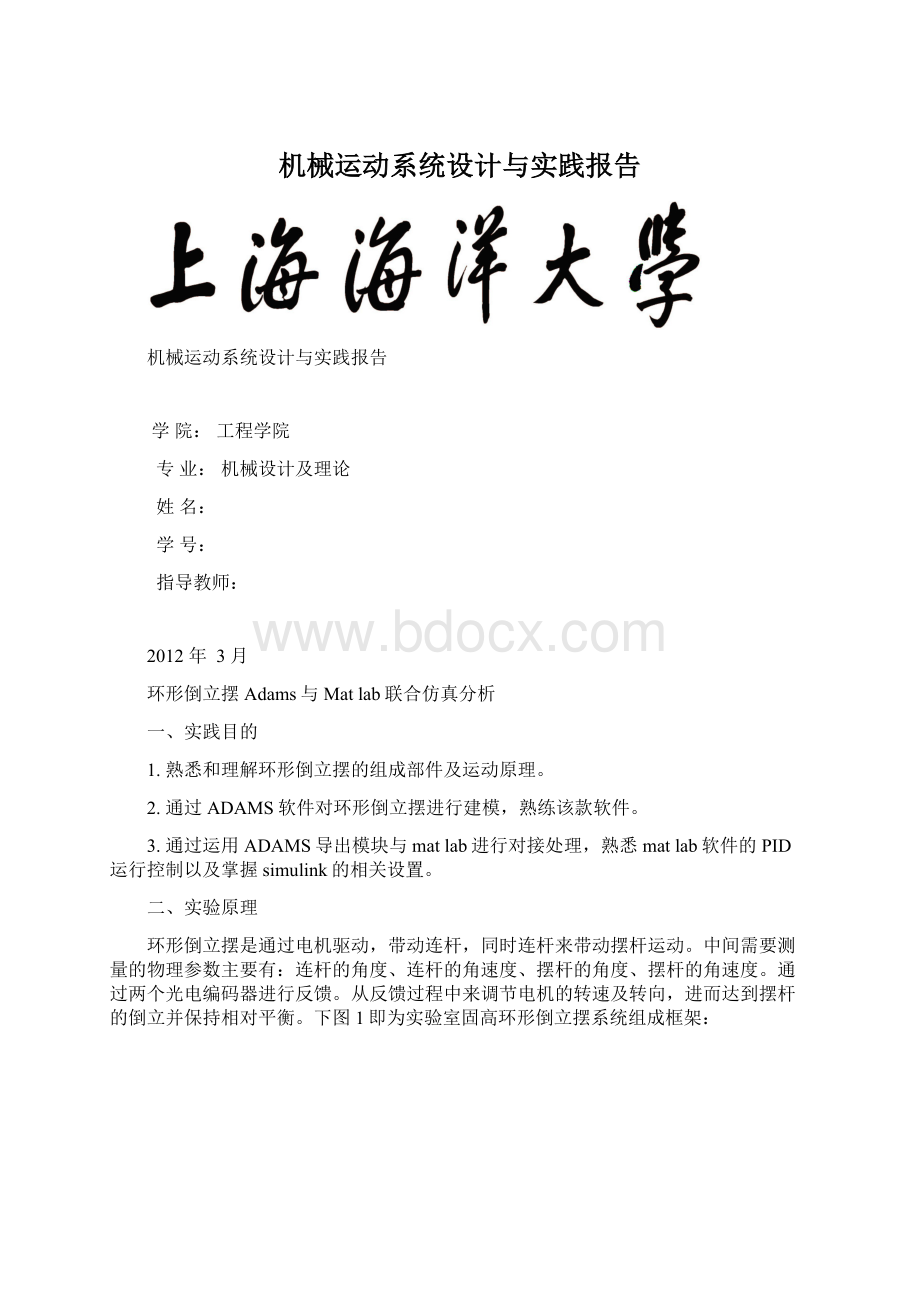机械运动系统设计与实践报告.docx
《机械运动系统设计与实践报告.docx》由会员分享,可在线阅读,更多相关《机械运动系统设计与实践报告.docx(44页珍藏版)》请在冰豆网上搜索。

机械运动系统设计与实践报告
机械运动系统设计与实践报告
学院:
工程学院
专业:
机械设计及理论
姓名:
学号:
指导教师:
2012年3月
环形倒立摆Adams与Matlab联合仿真分析
一、实践目的
1.熟悉和理解环形倒立摆的组成部件及运动原理。
2.通过ADAMS软件对环形倒立摆进行建模,熟练该款软件。
3.通过运用ADAMS导出模块与matlab进行对接处理,熟悉matlab软件的PID运行控制以及掌握simulink的相关设置。
二、实验原理
环形倒立摆是通过电机驱动,带动连杆,同时连杆来带动摆杆运动。
中间需要测量的物理参数主要有:
连杆的角度、连杆的角速度、摆杆的角度、摆杆的角速度。
通过两个光电编码器进行反馈。
从反馈过程中来调节电机的转速及转向,进而达到摆杆的倒立并保持相对平衡。
下图1即为实验室固高环形倒立摆系统组成框架:
图1环形倒立摆组成框架
机房中matlab6.5中控制倒立摆的原理
图二
老师给的程序
%thisisanewsimulationprogramfornewarm-typeinvertedpendulum
%bylgrinputonthestateof0ofarmandthatof0ofpendulum
%!
CAUTION,changedbaseofdirectionofarm
%Suc.
clearall
closeall
%---------------------------------
Ma=0.21;
Mp=0.062;
la=0.133;
lp=0.068;
La=0.25;
Lp=0.19;
Ja=5E-3;
Jp=5.65E-4;
Ca=5.52E-3;
Cp=1.69E-4;
kt=0.0419;
g=9.8;
%------------------continuousstateequation--------------------
ce=[1000;
0100;
00Mp*La^2+JaMp*La*lp;
00Mp*La*lpJp];
ca=[0010;
0001;
-(Mp*la+Mp*La)*g0-(Ca+Cp)Cp;
0Mp*g*lpCp-Cp];
cb=[0;0;kt;0];
CA=inv(ce)*ca;
CB=inv(ce)*cb;
C=[1000;0100];
%---------------------------------------------------------------
Q=diag([100,10,1,1]);
R=1;
[f,s,e]=lqr(CA,CB,Q,R);
%---------------------------------------------------------------
dt=0.005;%samplingtime
th_a=0.1%accdd('Initialangleofarm',0.1);%!
caution,clockdi
%rection
th_p=pi;%=accdd('Initialangleofpendulum',pi);%!
caution,clockdir
%ection+
d_th_a=0.0;%
d_th_p=0.0;%initialvaluesofstates
dd_th_a=0.0;%
dd_th_p=0.0;%
u=0.0;
z=0.0;
energy=0.0;
i=1;
%--------------------------inputparameter---------------------
alpha=30.0;%alpha=accdd('DesignParameteralpha',30.0);
energy_d=1.5*Mp*g*lp;%accdd('DesiredEnergy',1.5*Mp*g*lp);
zeta=1%accdd('DampingFactor',1.0);
wc=1%accdd('DampingFactor',1.0);
flag=0;
%--------------------------startingloop----------------------
fori=1:
6.0/dt
th_a_0=th_a;%
th_p_0=th_p;%
d_th_a_0=d_th_a;%
d_th_p_0=d_th_p;%
dd_th_a_1=dd_th_a;%
dd_th_p_0=dd_th_p;%
ifcos(th_p)>=cos(0.2);
flag=1;
end
ifflag==0%-----------------------swimpingup------------------
dd_th_a=z-(2*zeta*wc*d_th_a+wc^2*th_a);
ydd_temp=-Mp*La*lp*cos(th_a-th_p)*dd_th_a+Mp*La*lp*d_th_a^2*sin(th_a-th_p);
dd_th_p=(ydd_temp+Mp*g*lp*sin(th_p)+Cp*d_th_a-Cp*d_th_p)/Jp;
d_th_a=d_th_a_0+dd_th_a*dt;
d_th_p=d_th_p_0+dd_th_p*dt;
th_a=th_a_0+d_th_a_0*dt+dd_th_a*dt^2*0.5;
th_p=th_p_0+d_th_p_0*dt+dd_th_p*dt^2*0.5;
else
eq_1_1=-Mp*La*lp*d_th_p^2*sin(th_a-th_p)-(Mp*la+Mp*La)*g*sin(th_a);
eq_1_2=-(Ca+Cp)*d_th_a+Cp*d_th_p+kt*u;
eq_1_left=eq_1_1+eq_1_2;
eq_2_1=Mp*La*lp*d_th_a^2*sin(th_a-th_p)+Mp*lp*g*sin(th_p);
eq_2_2=Cp*d_th_a-Cp*d_th_p;
eq_2_left=eq_2_1+eq_2_2;
%--------------------------calculationofinversematrix-------------
M11=Mp*La^2+Ja;
M12=Mp*La*lp*cos(th_a-th_p);
M21=Mp*La*lp*cos(th_a-th_p);
M22=Jp;
M=[M11M12;M21M22];
MI=inv(M);
%-------------------calculationofparameters------------------
dd_th_a=MI(1,1)*eq_1_left+MI(1,2)*eq_2_left;
dd_th_p=MI(2,1)*eq_1_left+MI(2,2)*eq_2_left;
d_th_a=d_th_a_0+dd_th_a*dt;
d_th_p=d_th_p_0+dd_th_p*dt;
th_a=th_a_0+d_th_a_0*dt+dd_th_a*dt^2*0.5;
th_p=th_p_0+d_th_p_0*dt+dd_th_p*dt^2*0.5;
end
energy=0.5*Jp*d_th_p^2+Mp*g*lp*cos(th_p);%energyofpendulum
potential=Mp*g*lp*cos(th_p);
kinetic=0.5*Jp*d_th_p^2;
%------------------------------------------------------------------------
ifflag==0
error=energy-energy_d;
u1=(Mp*La^2+Ja)*dd_th_a+Mp*La*lp*cos(th_a-th_p)*dd_th_p+(Ca+Cp)*d_th_a;
u2=Mp*La*lp*d_th_p^2*sin(th_a-th_p)+(Ma*la+Mp*La)*g*sin(th_a)-Cp*d_th_p;
u=(u1+u2)/kt;
z=alpha*d_th_p*cos(th_p)*error;
else
u=-f*[th_a;th_p;d_th_a;d_th_p];
end
%-----------------Limitinput--------------
ifu>=4.995
u=4.995;
elseifu<=-4.995
u=-4.995;
end
end
%----------------------------savedata----------------------------
accel_th_a(i)=dd_th_a;a的加速度
accel_th_p(i)=dd_th_p;p的加速度
veloc_th_a(i)=dd_th_a;a的速度
veloc_th_p(i)=dd_th_p;p的速度
angle_th_a(i)=th_a;a的角度
angle_th_p(i)=th_p;p的角度
Energy1(i)=energy;能量方程
Energy2(i)=kinetic;动力方程
Energy3(i)=potential;
input(i)=u;
t(i)=i*dt;
end
%----------------------------endloop-------------------------------
subplot(221);plot(t,angle_th_a);
xlabel('time[sec]');
ylabel('AngleofArm[rad]');
grid
subplot(222);plot(t,angle_th_p);
xlabel('time[sec]');
ylabel('AngleofPendulum[rad]');
grid
subplot(223);
plot(t,input);
xlabel('time[sec]');
ylabel('Input');
grid
subplot(224);
plot(t,Energy1,t,Energy2,':
',t,Energy3,'--');
xlabel('time[sec]');
ylabel('EnergyofPendulum');
程序中的一些句子
%thisisanewsimulationprogramfornewarm-typeinvertedpendulum这是一个新臂型倒立摆的新的仿真程序
%bylgrinputonthestateof0ofarmandthatof0ofpendulum由lgr输入的手臂0和0摆的状态
%!
CAUTION,changedbaseofdirectionofarm注意,改变基